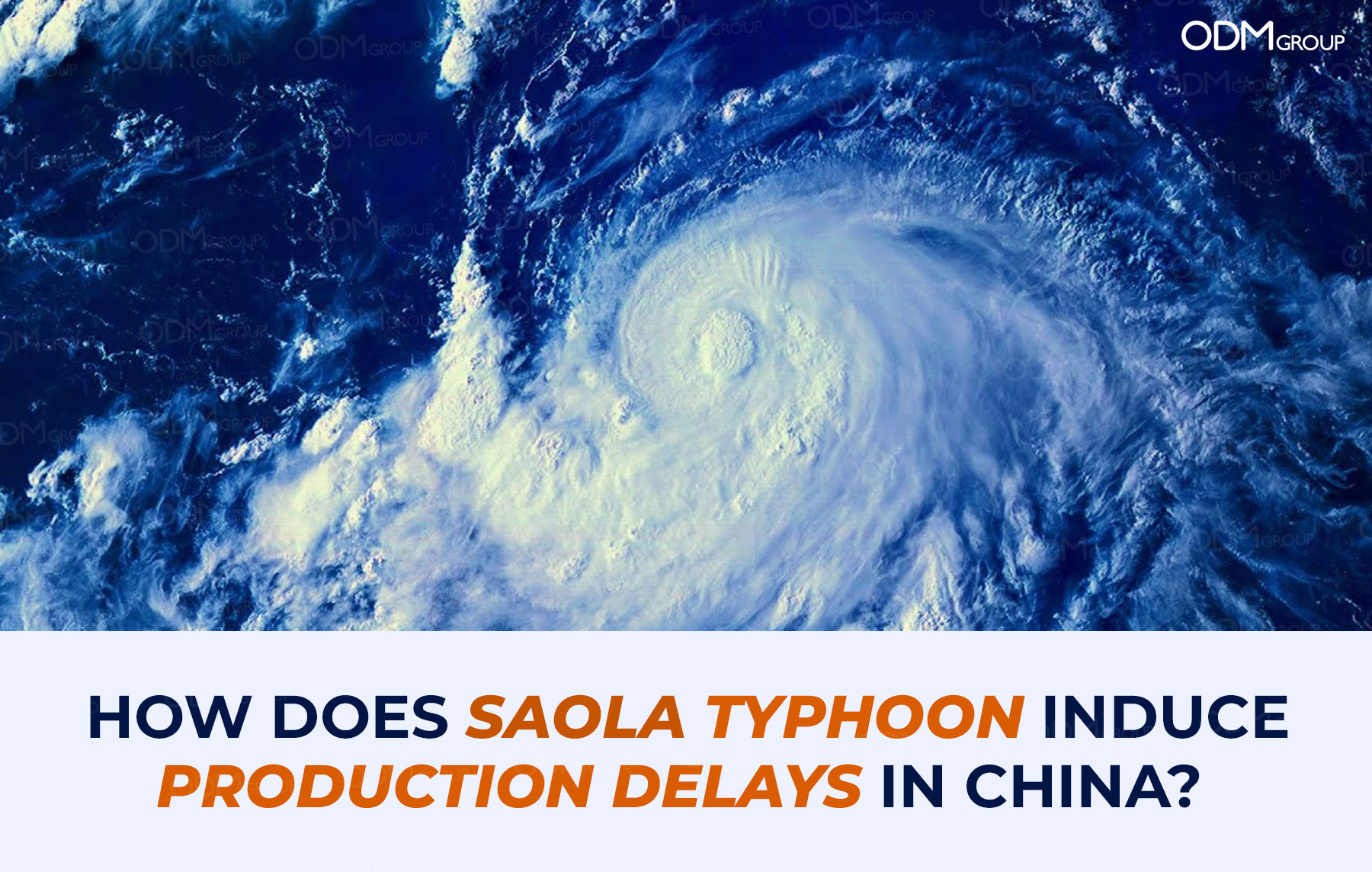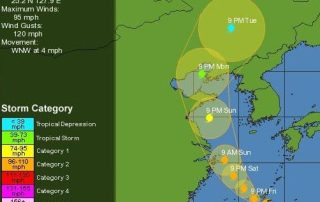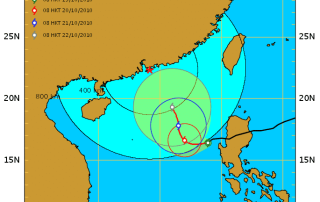According to the Hong Kong Observatory‘s present forecast track, super typhoon Saola is expected to trail the northeastern part of the South China Sea and towards the coast of eastern Guangdong today and tomorrow, edging closer to the vicinity of the Pearl River Estuary gradually.
Saola will make landfall along the coast somewhere from Huilai County in Guangdong to Hong Kong on the afternoon to the night of Sept. 1. It could be among the five strongest typhoons to land in Guangdong since 1949.
As such, the typhoon is expected to cause product delays in China, affecting local and international businesses.

How to Categorize Typhoons in Hong Kong?
- Standby (Signal 1): Used to signal any tropical cyclone within 800km of Hong Kong. Necessary precautions must be taken.
- Strong Wind (Signal 3): Definite warning given – Strong wind is blowing or expected to blow near sea level, with gusts that may exceed 110 km/h. A tropical cyclone is expected to come near enough to Hong Kong to cause strong winds in Hong Kong.
- Gale or Storm (Signal 8): A warning of a gale or storm in one of the four quadrants (NW, SW, NE, SE). Storm force wind is blowing or expected to blow near sea level, with gusts that may exceed 180 km/h.
- Increasing Gale or Storm (Signal 9): Indication given – Gale/storm expected to increase significantly in strength.
- Hurricane (Signal 10): A warning is given – of hurricane-force winds. Hurricane-force wind is blowing or expected to blow with gusts that may exceed 220 km/h.
Top 5 Impact of Typhoons on Production
Typhoons can cause so many product delays and troubles. In 2018, super typhoon Mangkhut also affected China. But how do these events affect production? Here are some of the huge impacts this devastating phenomenon can have on China and other countries such as Hong Kong.
1. Factory Closures
There are massive inconveniences to factories whenever a typhoon approaches or hits. Factory work is limited, as precautions have to be taken before the hurricane hits. Furthermore, everyone will have to stay indoors when the hurricane hits, which would halt all factory work.
2. Vulnerability of Coastal Manufacturing Hubs
China’s industrial prowess is concentrated in coastal regions, where bustling cities and sprawling factories thrive. However, this geographical advantage becomes a vulnerability when typhoons strike.
Coastal areas are susceptible to flooding, which can inundate factories, warehouses, and transportation infrastructure. Moreover, strong winds can cause structural damage, further hampering production capabilities.
3. Disrupted Transportation and Logistics
Typhoons can cause trouble in transportation networks, causing road closures, flight cancellations, and port shutdowns. These disruptions ripple through supply chains, hindering the flow of raw materials, components, and finished products.
Manufacturers may be unable to receive crucial inputs or ship out their goods, resulting in delays.
4. Electricity Supply and Power Outages
A steady supply of electricity is the lifeblood of modern manufacturing. Typhoons can disrupt power distribution networks through downed power lines, damaged transformers, and flooding of power stations.
As factories rely on a consistent flow of energy to operate machinery and maintain controlled environments, power outages can bring production to a grinding halt.
5. Worker Safety and Well-Being
Amidst the chaos of a typhoon, ensuring the safety of workers becomes paramount. Employers are faced with the challenge of either halting operations to safeguard their workforce or risking the well-being of employees by continuing production under difficult conditions.
Both choices have consequences – stopping production leads to delays while pushing ahead can endanger lives.
What Businesses Should Do When Their Supplier Production is Affected by Typhoons?
When a business’s supplier is affected by a typhoon or any other natural disaster, it can significantly disrupt the supply chain and impact the production process. Here are the steps that a business should consider taking in such a situation:
1. Communication:
- Reach out to the affected supplier as soon as possible to inquire about their situation, damage extent, and recovery timeline.
- Maintain open and transparent communication to understand the potential impact on your supply and production.
2. Assess Impact:
- Evaluate the severity of the disruption and the supplier’s ability to fulfill orders in the near future.
- Determine which specific products or components are affected and the criticality of these items to your production.
3. Identify Alternatives:
- Identify backup suppliers or sources for the affected products or components.
- If possible, establish relationships with multiple suppliers to avoid overdependence on a single source.
4. Adjust Production Plans:
- Modify your production schedules based on the availability of alternative suppliers.
- Prioritize the production of products that are most critical to your business and customers.
5. Collaborate with Suppliers:
- Collaborate with the affected supplier to explore potential solutions, such as expedited production or shipping once they recover.
- Understand their plans for resuming operations and incorporate this information into your own planning.
Review some of the most devastating typhoons that hit China and other nearby countries:
Super typhoon Hato affected Zhuhai in August 2017. Check the details in this blog.
Typhoon Haima interrupted the HK Megashow in December 2016. Learn more about the storm details here:
In 2011, Hong Kong was severely affected by Typhoon Nesat. It caused the closure of most offices and factories in the country.
Severe Typhoon Megi disrupted Hong Kong and China operations in 2010. This caused trade shows in the region and our Mega Show that year.
Other causes of production delays in China:
An article on how pollution inspections caused temporary closures for factories in Guangdong. Certainly relevant as typhoons cause pollution levels to rise just before they hit Hong Kong. We hate that as much as we do the Typhoon!
China’s national day holidays can change at a moment’s notice, give this article a read to check when the holiday week occurs.
Some articles on how Golden Week in China affects production are certainly worth a read.
An article on calculating shipping time is certainly effective in helping you check if you’re on schedule!
Some articles on shipping delays. Learn how can they cause trouble in businesses and consumers.
In Conclusion
Based on the analysis above, typhoons have the potential to severely affect factory productivity and transport. This, in turn, could cause severe production delays. In particular, for this case, there could be a severe impact on production times in Hong Kong and Southern China. This would therefore affect projects concentrated within Hong Kong and Guangdong.
Therefore, everyone should be prepared when such events come. They may affect your business, but everyone’s safety should always be the top priority.
Production Delays FAQs
All you need to know about production delays!
Why are typhoons a significant cause of production delays in China?
Typhoons bring a potent combination of heavy rainfall, strong winds, and flooding, which can disrupt transportation, damage infrastructure, and threaten worker safety. China's coastal manufacturing hubs are particularly vulnerable to these natural disasters, as they often house critical factories and supply chain nodes. The resulting disruptions to logistics, power supply, and workforce availability can lead to substantial delays in production processes.
How do product delays in China due to typhoons impact global industries?
China's manufacturing sector is a linchpin in the global supply chain, touching industries ranging from electronics to automotive manufacturing. When production in China faces delays due to typhoons, supply chains are interrupted, leading to shortages of goods and components worldwide. The interconnectedness of these supply chains means that even a single disruption can have cascading effects, affecting industries and consumers in various parts of the world.
What measures are being taken to mitigate product delays during typhoon season in China?
Companies operating in China are adopting a multi-faceted approach to mitigate production delays during typhoon season. This includes investing in infrastructure resilience to protect factories from flooding and wind damage, incorporating advanced weather forecasting to adjust production schedules, and implementing flexible manufacturing processes that allow for quicker recovery from disruptions. Additionally, the Chinese government is working on policies that emphasize disaster preparedness, and there's a growing focus on leveraging technology, such as AI and data analytics, to enhance risk assessment and response strategies.




